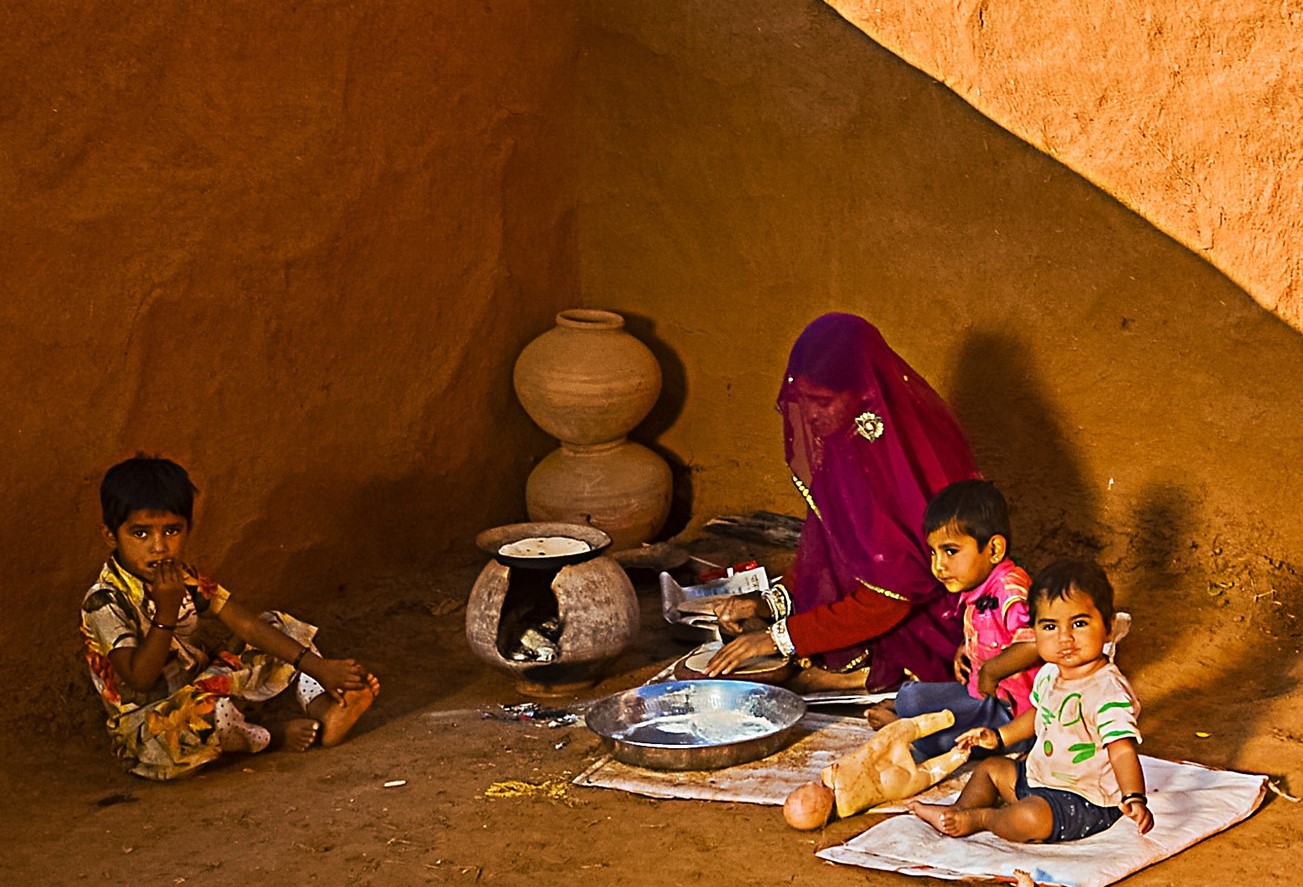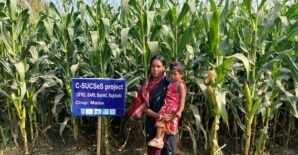BY KALYANI RAGHUNATHAN
India’s policy response to containing COVID-19 pandemic – the lockdown approach – enforced nationwide restrictions on movement leading to a combination of widespread unemployment alongside disruptions to food supply chains. Kalyani Raghunathan argues that rising food prices due to supply chain disruptions will increase the overall cost of nutritious diets, making a diverse diet less affordable. Recognizing government’s relief measures to help mitigate food and nutrition insecurity, she cautions against relegating nutrition goals, while solving issues of hunger and food security- Rasmi Avula, series co-editor and Research Fellow, Poverty, Health, and Nutrition Division (PHND)

Jaisalmer: Rural woman cooking in her house and feeding her children during lockdown due to Covid-19. ShutterStock/stockpexel
As of April 27, India’s lockdown – the largest of its kind in the world, affecting 1.3 billion people – entered its sixth consecutive week, with many states deciding to extend it to May to prevent a resurgence in cases. Though some restrictions have been eased in the recent weeks, many non-essential services remain unavailable, leading to widespread unemployment, especially in the urban informal sector. The Centre for Monitoring India’s Economy (CMIE) recently reported that the urban unemployment rate had risen to 30.9%, while the overall rate was 23.4%.
Impact on rural poor and migrant workers
The sudden announcement of the lockdown resulted in a panic exodus of migrant workers back to their homes in Bihar, Uttar Pradesh, Jharkhand, and other states. Facing an uncertain future in the cities – with no incomes and no assurance of food or shelter – many preferred to return to their villages, where they were certain of at least having a roof over their heads and food in their stomachs. However, while the promise of a roof might remain, there is no guarantee that returning home will ensure food security, neither for the migrant workers nor for their families.
Rural-urban migration in India is widespread, with a recent World Bank report estimating close to 40 million internal migrants, most of whom were driven by economic necessity. Remittances account for a large proportion of monthly family incomes, estimated at 25-50%. In some states like Bihar, this income forms as much as one-third of state GDP. Within the first few days of COVID-19 lockdown, there was a huge reversal of rural-urban migration, and it is estimated that 500-600,000 migrants left for their homes on foot, with even more crowding onto buses and trains. As political scientist Christophe Jaffrelot said in his recent interview with The Wire, the COVID-19 crisis is a “double-edged sword for the rural poor”. On the one hand, loss of jobs in the urban sector and the resultant reverse urban-to-rural migration will reduce or eliminate remittance incomes and increase the number of mouths to feed. The World Bank report projects a reduction of 23% in remittance income in India in 2020. On the other hand, disruption of agriculture supply chains and the closing of mandis and haats have made it difficult for rural agricultural households to sell their rabi harvests. Finally, the increased presence of male workers in rural areas could squeeze women out of the workforce. Where there is a limit to the number of days one can work – such as on the Mahatma Gandhi National Rural Employment Guarantee Act (MGNREGA), which guarantees 100 days per household – an increase in male labor supply necessarily comes at the cost of a 1:1 reduction in female labor supply. When both the size of the overall pie and the share of it that women can exercise some control over diminish, there can be implications for a whole range of outcomes.
Dealing with India’s food and nutrition systems
One of those outcomes relate to food and nutrition security, particularly of vulnerable groups such as children or pregnant and lactating women. There are growing concerns that the COVID-19 crisis will turn into a food crisis for the poor in India, a segment of the population for which food and nutrition security was limited even in the absence of a crisis of this magnitude. Our primary survey data from select areas of five states in 2017 shows that the proportion of adult household members consuming a minimally diverse diet (defined as 5 out of 10 food groups for women and 4 out of 7 for other adults) was as low as 3-4% in some states. Most adults in these five states ate only cereals, pulses and other vegetables. A very small proportion of adults or children in either of the surveys consumed dark green vegetables, fruits and animal-sourced food. What is even more worrying is that less than 3% of the households in our survey were classified as being food secure (using the Household Food Insecurity Access Scale). The remaining 97% experienced varying degrees of food insecurity. Even acknowledging sample selection bias, these percentages are staggering. The World Food Programme recently warned the world of being on the brink of a second pandemic, i.e., hunger. And in the absence of immediate and targeted action, this dire warning could prove true for India.
Affordability of nutritious food
Our analysis of publicly available price data from 2001 to 2011 suggests that the lack of affordability of nutritious food could be one reason for poor diets. Taking into account district-level variation in price and availability of more than a hundred distinct food items, the paper uses linear programming (a technique that optimizes a linear objective function, here total cost of a diet, subject to certain constraints, in our case, the combination of food groups the diet must contain) to construct the least-cost diet that meets India’s Food-Based Dietary Guidelines (FBDGs). We then compare this cost to the daily wages of male and female unskilled laborers, the closest available representation of the wages of the poor. We find that a nutritious diet is almost prohibitively expensive over the period 2001-2011, costing about 50-60% of male and 70-80% of female daily unskilled labor wages. This per-individual per-day least-cost diet does not take into account other family members, tastes and preferences and other non-food costs, which would only serve to increase costs, and thus provides a possible explanation for poor dietary diversity, which is that nutritious diets are simply unaffordable by large swathes of the population.
In today’s world, rising food prices as a result of the COVID-19 crisis will certainly exacerbate both food and nutrition insecurity. Reduced arrivals of food at wholesale markets, the increased restrictions and expense of land transportation, and the severe shortage of labor (often migrant labor) at various points along the food supply chain has served to increase prices several-fold since the start of the crisis. Nutritionally important food items like fruits, vegetables and milk are hardest hit, as these are the most dependent on functional supply chains, owing to their perishability and susceptibility to damage. However, prices of key staples and lentils have also risen dramatically. Our 2001-2011 analysis shows that the largest contributors to the cost of the least cost nutritious diet were dairy and staples, with fruits and vegetables also contributing significantly (Figure 1).i.In the wake of disruptions to those supply chains as a result of COVID-19, the prices of those items that contribute greatly to the overall cost of a nutritious diet have already increased, and are likely to go up even further, making a diverse diet even less affordable.

Figure 1: Contribution of food groups to overall cost of diet, 2001-2011 (Author's calculations, see text for source, data missing for 2008)
Policy response to food and nutrition security
Government relief measures such as the additional provision of rice/wheat and pulses through the Public Distribution System (PDS), the provision of grocery kits containing rice, pulses, oil, spices and vegetables, and the home delivery of school meals and other nutrition programs in some select states are all welcome policy initiatives to help bolster food and nutrition security. For those households that fall between the cracks of these social protection programs, however, it is important to ensure that food prices and availability are not compromised. Some NGOs are providing encouragement or incentives to farmers to grow food rather than cash crops in the upcoming kharif season. If this could be a part of the national policy response, along with the provision of seeds and other inputs, it would certainly help in the medium run as well.
Indian government had only recently made nutrition an explicit policy priority with the institution in 2019 of the national nutrition mission, Poshan Abhiyaan, and its goal of a malnutrition-free India by 2022. This mission is undoubtedly going to face serious setbacks as a result of the worsening economic crisis. At the same time, the enforcement of social distancing will limit the convening of communities or the use of service-delivery platforms like anganwadi centers. Now with the easing of restrictions in some areas and the resumption of select economic activities, some migrants might be able to find work again, but the stress on family incomes is unlikely to be resolved in the near future. With first-order problems like hunger and food security becoming central to the discussion, the commitment of the government to its nutrition goals might take a backseat. Let us not lose sight of those goals or compromise on the momentum and progress we have made in the last five years.
Kalyani Raghunathan is a Research Fellow with IFPRI’s Poverty, Health, and Nutrition Division (PHND). The analysis and opinions expressed in this piece are solely those of the author.
This blog has been published as a part of the International Food Policy Research Institute (IFPRI), South Asia, blog series on analyzing the impacts of the COVID-19’s pandemic on the sub-national, national, and regional food and nutrition security, poverty, and development. To read the complete blog series click here
i This is an updated figure, relative to the discussion paper, but the qualitative conclusions remain the same.



